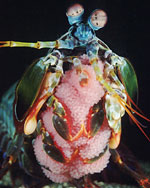It must be love (Reproduction)
Pseudosquilla ciliata reproduces in a
very interesting and very different way than most other crustaceans. In
most crustaceans, females have a high demand for large males. Females
are attracted to these larger males usually becuase obtain an appendage which is strong
for grasping their prey. When multiple males are present in the
same vicinity of a female crustacean she will usually choose her mate by
deciding which male would be suited
best fit to help reproduce the most successful offspring (Wortham-Neal,
2012).
In Pseudosquilla ciliata though, these type of "normal" mating roles have been reversed. This type of role reversal in P.ciliata was the first found account within the crustaceans (Hatziolos, 1983). In P.ciliata, the males do not try and impress the females, but this courtship is reversed. The female P.ciliata need to impress the male. This type of role reversal is explained to have happened because of no apparent male figure being around during a young stage, this is also known as female guarding (Hatziolos, 1983). Females impress male P.ciliata by using visual displays as well as by putting on a sexual chase (Hatziolos, 1983). When males of this species chose which type of traits they want in thier female partner, they usually prefer females bigger than their own body size (Hatziolos, 1983). By choosing larger females, the males lessen the possible loss of competing sperm (Hatziolos, 1983).
When the males begin deciding which female they
they want to mate with, they are at risk of multiple dangers. These dangers
include the strong aggression female P.ciliata possess (Hatziolos,
1983). The males still do not
avoid the aggression these females display though (Hatziolos, 1983).
Due to both of these factors, males use a great deal of caution but they
still still choosing larger females because their sperm has a better
chance of fertilizing a females egg (Hatziolos, 1983).
To initiate courthship, females
P.ciliata use a structured technique to impress the male she wants
to impregnate her.
There are many different ways that the female P. ciliata tries to
attract a male partner.
One of these techniques is the meral spread, this action exposes the female’s appendages giving off a bright blue propodi (Hatziolos, 1983). Another technique is the sync-jerk, this action is similar to the way a seal beats its front legs (Hatziolos, 1983). The P. ciliata does this while staying in the same position (Hatziolos, 1983). Females of this species are also known to take part in a technique called the dive, this is where the female tries to force her body under the male she is trying to attract (Hatziolos, 1983). A technique more subtle is one called a weak strike which is nearly a tap on the males body (Hatiziolos, 1983). The last technique and one of my favorites is called the Avoid, this action is similar to the way humans sometimes attract their partners (Hatziolos, 1983). The avoid consists of quickly backing away from your partner when they come near, similar to a type of tease (Hatziolos, 1983). A few of these techniques can be seen in this short clip. These are only a few of the interesting ways that the female P.ciliata initiates courtship with a male of the same species. If you want to learn about more of these interesting techniques, I would recommend checking out this study called Role reveral in courtship in the stomatopod Pseudosquilla ciliata (crustacean), this study was done by Marea E. Hatziolos and Roy L. Caldwell.
Before courtship occurs, both the male and the female get together to make sure that they are under the right condition to reproduce (Hatziolos, 1083). Then the female continues by doing her long process of intricate techniques. After the female is finally successful in attracting her mate, intercourse occurs which lasts only about fifteen seconds but this courtship in total lasts about twenty minutes (Hatziolos, 1983). This process can take place in the open or in a secluded burrow nearby (Hatziolos, 1983).
Click to continue for more Fun Facts or pictures in our Gallery!
Or click to return to Home!
